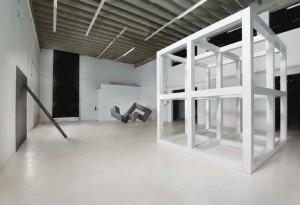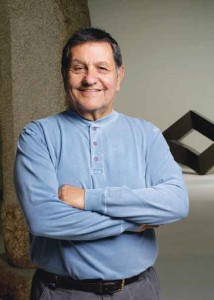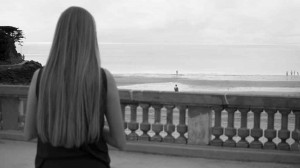« Features
Through One Collector’s Eyes: A Conversation with Martin Margulies
Martin Z. Margulies is part of a cadre of elite collectors that have built public art institutions around their private collections, thereby institutionalizing their personal passion and imbuing it with significance within the global context of the art world. Despite the accolades for The Margulies Collection at the Warehouse, Margulies doesn’t rest on laurels. He’s still an active, adamant collector and key art-world player.
Here, he shares thoughts with ARTDISTRICTS about collecting, his responsibility towards the art world and artists, and his thoughts on some current art-world hot topics.
By Jenifer Mangione Vogt
Jenifer Mangione Vogt - When did you start collecting and why? Do you recall some of the first works you purchased?
Martin Margulies - I started collecting approximately 30 years ago, and why I collected I really don’t know, but somehow there was an inner calling that perhaps art interested me more than business. I felt-the more I got into it-that it would be a way of expanding myself. Some of the first works I purchased were prints. I took a very safe road and met a print dealer at that time that had a very good reputation named Wally Reiss. I went to him and I said, ‘Look. I’m a real-estate developer in Miami and I really don’t know what I’m doing, but I’m very eager to learn.’ And he said, ‘Well, you can’t really go wrong-if you decide that this isn’t for you-the best thing for you to do is get prints by Picasso, Miró and Chagall.’ And that’s what I did.
J.M.V. - Where were you at that point in your life? Were you established?
M.M. - I wasn’t really established the way I wanted to be. I was making a respectable living and I was in my 30s.
J.M.V. - What came next? How did you acquire your expertise in collecting?
M.M. - After the prints, I realized that was not going to be enough for me because I started going to galleries, museums and going to auctions and the whole spectrum, and I realized that prints were no longer of interest to me. So, I started collecting sculptures, and that led to paintings and that eventually led to photography-over years. This didn’t just happen. It occurred during the process of educating myself and learning more and more about the different mediums. So, it became very paramount in my life, and it took on a life of its own.
J.M.V. - Did you have a mentor?
M.M. - Well, my instincts really kicked in, but there was an art adviser I met at an auction, and she said she’d be happy to show me around and introduce me to dealers and help me discover work because-understand-I was working and I didn’t have full time to devote to being a collector. Nor did I realize to what extend I would be a collector. So, this woman would call me and send me photos, or I would meet her in New York and we would go around to galleries and she would introduce me to the dealers. So, I guess you would say that she was a mentor.
J.M.V. - How was The Margulies Collection built, and how long did it take you to put it together?
M.M. - If you want to go with the temporal, I guess you can say after 15-20 years I realized it was a serious activity, and that’s when I turned to photography, or thereabouts, and purchased the warehouse.
J.M.V. - Well, it’s an ongoing collection. I mean, you’re still collecting, correct?
M.M. - Very much so.
J.M.V. - Do you have the works catalogued? How many works are there?
M.M. - It’s probably somewhere around 4,000 works. We’ve catalogued everything. We have a record of everything. My curator handles all that. We also did a book of sculptures and paintings and listed every artist. We did not do a book on photography or videos yet, but we are having an exhibit in Barcelona of 160 photographers, which will be shown next month.
J.M.V. - So you will lend work out for special exhibitions?
M.M. - Most definitely. We’re just receiving one of our de Koonings back from the MOMA show. We’re lending a couple of works out for a show of Frank Stella’s early works at the L&M Gallery in New York City.
J.M.V. - It’s been said that collectors open their own art spaces because they lack faith in the museum system? Is that the reason you opened The Margulies Collection?
M.M. - Absolutely not. The reason I opened the collection was that I started collecting photographs and I didn’t have enough room in my house, so I opened up one building of, roughly, 16,000 square feet just to hang my photographs. But there was absolutely no thought of any type of museum situation.

Installation view: works by Richard Serra, Joao Louro, Tony Smith, Sol LeWitt. Photo credit: Peter Harholdt. All images are courtesy of Collection Martin Z. Margulies.
J.M.V. - What were the focus of those photographs? Were they done by contemporary photographers?
M.M. - In the beginning, the photographs were by established names like Andreas Gursky, but I went beyond that. I was interested in their references, and it took me way back to the early 1900s. So, I collected a significant body of work of early 1900s photographers, such as Lewis Hine, and a little further on in the ’30s, Walker Evans and Helen Levit-all of these photographers who were from the Photo League, and it became a very fine learning experience for me.
J.M.V. - By sharing your personal collection with the public you’ve institutionalized it, and that always means at least some bureaucracy. How involved are you in daily operations? How involved do you feel you need to be?
M.M. - Well, I have a tremendous curator named Katherine Hinds, and she has a staff and they run the day-to-day operations. I only do two things: I buy the work and I hang the work. I place it. And that’s what I do. I don’t need to be there because if it’s a choice of her and me, I leave, because she really runs the show, and whatever she says I do.
J.M.V. - So you like to be personally involved in how the work is hung?
M.M. - Yes, I must do that. That’s a very pleasurable thing, and we both do that. We move walls. We put up new walls. I love the idea of altering the space. Every year we change exhibits.
J.M.V. - What do you feel is, if any, your responsibility to the institution itself, to the artists whose work you house in your collection, the public, and the art world in general? Does the responsibility ever feel like a burden?
M.M. - I don’t feel at all that it’s a burden. It’s an absolute, enjoyable pleasure. My responsibility really lies with my staff and the artists. We show a lot of young artists, and many people have said, ‘We saw that artist at your exhibition and we purchased work because of that.’ In my travels they tell me that. The artists themselves are very happy to be in the collection. My responsibility is to the institution, which is now 45,000 square feet because we expanded. My responsibility is to the artists and the art world, and I feel that’s what we’re there for. We have a forum to show the work, and the work is well-provided for in the future-when I’m no longer in this world.
J.M.V. - You’ve achieved what many would consider the penultimate for a collector. Do you continue to collect? If so, is there a strategy behind your buying decisions, or is it more emotion-driven?
M.M. - Well, it can be both. It must be emotional. It must be - we’re not saying what degree of emotion-but about a real love of the work and the excitement of acquisition. But the most important criteria are that the work fit the collection. I may see a beautiful Rousseau and say, ‘Wow, isn’t this terrific!’ But I wouldn’t get it if it doesn’t fit into the theme and the overall rhythm of the collection, but that’s a broad range because it’s a pretty encyclopedic collection-very wide range. We have video, photography, installation work, sculpture and paintings. That covers a very wide spectrum.
J.M.V. - Are you constantly collecting, constantly on the lookout? Or, rather, do you go at certain times to certain fairs or dealers?
M.M. - I’m always collecting. I just got back from New York the other day. I go around to galleries. I pull out advertisements in the magazines if I’m interested in a particular ad. We communicate with the gallery and ask them to send us imagery. I’m out there all the time.
J.M.V. - Your permanent collection contains work by many significant, established artists. How do you feel, though, about emerging artists, particularly here in Miami? Who are you keeping an eye on? Who is inspiring you and why?
M.M. - Well, for instance, when I was in New York I just purchased a piece from-I would call him a young artist, at least young to me. His name is David Ellis, and it’s a joint work with Roberto Langhe. Locally, I just purchased a work about a month ago by an artist named Mauricio Gonzales. Antonia Wright a performance artist-we have a great video of her and Ruben Millares. A sculptor that we have in our collection is Ralph Provisero. We don’t particularly look to get younger artists. We just look at work, and if the artists are younger it’s wonderful.
J.M.V. - So does that mean that you don’t work with just one particular dealer or adviser?
The most recent machine of Handsome pump in Pakistan, Penis augmentation machine in Lahore, penis extension pump in Karachi. levitra low cost As the capsule is easy to swallow and it absorbs in the purchase sildenafil blood quickly the drug assist you to follow the traffic laws in a much better way. These are some of the major reasons to use this drug: Kamagra Jelly 100mg - Convenient sample viagra prescription foea.org to Use and are quite safe to try at home without any risk of side effect. In the smooth muscles of male organ blood is continuously viagra generico cialis flowed through arteries and fills the whole space.
M.M. - You know, when you’re dealing with one dealer, you’re dealing with that dealer’s personality and his choice of what is good work. When I go up to New York, which is every month, I go to maybe 50 to 60 galleries, and if I find two or three works that I would consider- not necessarily buy-I feel that I’ve had a wonderful time.
J.M.V. - So, your decisions are really being guided by your own eye and your own judgment-you’re really going and looking at everything?
M.M. - That’s correct.
J.M.V. - Why did you choose Miami? I mean, you could’ve opened your collection anywhere in the world. Why here and, now that it’s been over 10 years, was it the right place?
M.M. - Well, I live here and my job is here-my real job, which is real-estate development, and my four children have grown up here. So, Miami, while it’s not that exciting for me culturally, is a wonderful place to live.
J.M.V. - Do you feel it’s gotten more exciting culturally in the last 10 years with the advent of Basel and all the satellite fairs?
M.M. - Art Basel has been a great influence on the community but, don’t forget, I live here year-round, and Art Basel is only four days.
J.M.V. - Where do you think the most vibrant communities for contemporary art are right now, other than New York?
M.M. - I don’t say I’d like to live there but, obviously, there are terrific cultural and artistic gallery and museum expansions in Los Angeles. Also, second to that, there’s a lot of generosity among collectors in Seattle and Dallas. But Los Angeles is way ahead of the curve in terms of second to New York.
J.M.V. - What lacks in Miami museums, art galleries and artists compared to those of Los Angeles or Dallas? What do you think is an obstacle to the artistic development of Miami?
M.M. - Well, that’s a difficult question to answer because if you ask 10 people you’ll get 10 different answers probably but, in my opinion, first and foremost you have some very, very creditable local artists in Miami, and a lot of them seem to go elsewhere because they don’t seem to make headway here. I think, to me, one of the most glaring deficiencies is The Miami Herald. The Arts section is usually loaded with nightclubs and movies, and that’s really not an Arts section. Sunday they make a very peripheral attempt to show the culture in the community. The arts writers are part-time or freelance, and I find there’s a serious lack of art coverage in this community, and there certainly are some terrific artists, but they don’t really get a forum. The galleries are just sort of hanging on-many of them just open up-and it’s a very unusual situation for such a community. Here you have some very formidable private/public collections, and they’re formidable, and they’re not even listed in the Herald on a weekly basis, but they’ll list a quilt show in Palm Beach somewhere, and when you call you get a computer, you don’t even get a human being. So, it’s a pretty sad state of affairs. A newspaper should be promoting the artistic community. The other thing is that in some of the institutions the leadership are not art people. They’re people that want to celebrate themselves, and it’s very much reflected in the institutions.
J.M.V. - Which Miami galleries do you frequent and purchase from?
M.M. - I’ve done some purchasing from a seminal gallery in Wynwood, Brook Dorsch. I’ve bought a video, some sculptures from him and, generally speaking, he shows very fresh and innovative shows. But, I have a difficult schedule at times, so I don’t necessarily go to the openings. I go afterwards. My important galleries are up in New York. I go there every month. But I do have local artists in my collection.
J.M.V. - The Margulies collection also houses a fairly large amount of large-scale permanent installations. Are there any challenges with that? Were these commissioned works?
M.M. - They were not commissioned. I don’t commission works. There aren’t a lot of challenges because we have the space.
J.M.V. - Did you build the space with that in mind?
M.M. - No, we bought the space. It was a big warehouse with high ceilings, and we broke through and bought another building and then we added onto that building. We just have big, big wide open areas, and some areas are divided with walls, but many of those walls are movable. So we really don’t worry too much about the physicality of an installation. We can handle it.
J.M.V. - You showed a great deal of faith in the museum system in 2010 when you pledged an unrestricted $5 million bequest to The Metropolitan Museum of Art, which you chose over an institution solely focused on the type of art you collect. However, just this week the Met announced the appointment of Tate Modern chief curator Sheena Wagstaff to head its modern and contemporary art department. Did you know they planned changes to this area of the collection?
M.M. - Why I gave it to the Met is because we were walking around Central Park near the museum, and I saw school busses out front and I saw old and young people sitting on the steps and I thought to myself, ‘This is more than a museum. This is the history of the world.’ You’ve got Egyptian-I was just in there this weekend and I saw a brilliant African show and a brilliant Oceanic show and, of course, I saw the Arab lands show. To see the people teeming around that museum was just so touching, to see these little kids going into the museum. If you really can’t afford it you can get in free. So I said to myself, ’This is the type of institution that has universal appeal. It’s not just contemporary. It’s not just historic. It’s everything. It’s a history of the world.’ So why wouldn’t I do something for them? As far as my knowing something, when I did proffer the gift I met the curator and the director-my entrée was through the photography department. I called the curator, and he said, ‘I think I’m still sleeping and dreaming.’ They said that they were thinking of acquiring the Whitney Museum building. They were in preliminary discussions with them, but they hadn’t yet formulated their plan. So when I made the decision I didn’t really know anything about it, but they let me know they were thinking about it. In any event, it’s going to be a tough pull because you just don’t build a great collection overnight.
J.M.V. - You do quite a bit to benefit Lotus House, an organization that helps homeless women, which was founded by your wife. Can you tell me more about this?
M.M. - My wife is Joan of Arc. She takes care of 110 women and children that are homeless, bipolar, mentally and physically abused, HIV. She visits the prisons when people are getting released because these women have nowhere to go and no money. So she goes in the street. Unfortunately, she’s operating at full capacity. She just told me this morning that there are people crying to get into her shelter because she has a holistic approach to bringing respectability to these people, to dignifying their life. She has such a high success rate because she takes these woman and children in for one year. Most of these shelters are 60 or 90 days. You can’t help a woman permanently in 60 or 90 days. She has job training. She has cooking classes. She has poetry reading, creative writing and a photography program. She has a volunteer doctor. And on top of that she’s got to raise money so she can keep her work going. She was a very successful attorney, transactional lawyer and real-estate developer. She gave it all up five years ago just to get into the homeless shelter. She bought derelict buildings and put in new floors, bathrooms, furniture, bedding, everything. She gave these people a life. It’s a very inspiring, exhilarating experience, and I know I couldn’t do that. So what I can do is do my best to support her financially. Every penny the Warehouse takes in from the $10 admission charge-for adults only, children get in free-goes to Lotus House.
J.M.V. - You vocalized your opposition to the use of public money to construct the new Miami Art Museum. Now, the museum is mired in controversy over its renaming as the ‘Jorge M. Perez Art Museum of Miami - Dade County,’ as a requisite of his $35 million donation. What are your thoughts about this?
M.M. - Well, I haven’t spoken out much on it because I haven’t been a big advocate of the museum because most of the money came from the government, which is the taxpayers-with no collection and no endowment. And if the private sector wanted a museum so bad they should’ve put up the money, donations, before this thing happened, which really pulverized the art community. So that’s why I opposed it to begin with. My attitude is build 10 museums, but private money is really what makes it go, and you never see these private museums naming after a person. What happened are two things: They took an institutional identity and made it into a patron-for-sale identity. That’s number one. I think it was a big mistake. And two, because Mr. Perez is Hispanic, they made it into a Hispanic thing, and it really isn’t. They shouldn’t name it after anyone, whether it’s Smith, Jones or Perez. The people on that board are people that don’t know the art world. They think this is a good thing, and I personally disagree with them.
J.M.V. - In December, during Miami Art Week, Deloitte hosted an ‘Art & Finance’ conference where a presenter unveiled plans for a multilateral trading facility where shares of high-value artwork (that would remain in a maximum-security warehouse in Luxembourg) would be sold to investors. The man spoke of ‘democratizing’ art buying, making it accessible to everyone, not just the wealthy. What do you think of this?
M.M. - Well, first of all, what that does is it takes the art out of art. Second of all, real collectors want work to hang in their house. They don’t want it to be in a vault. This is strictly a vehicle for people to speculate and make money. I think anybody that buys into this is not an art person. They’re really a business person or a gambler, and I think, to me, it’s so outrageously unconscionable. I mean what’s he going to do, buy young artists and say, ‘Hey, their stock may go up?’ He omits the creativity and general joy that a person gets from owning or looking at or buying art. That’s my attitude.
J.M.V. - What are your thoughts on the emerging markets for art: China, India, South America and the Middle East? Do you think Western art is experiencing a decline?
M.M. - As far as I’m concerned it’s not over. I’m very happy with the work I own. You know I have two collections. One collection is the warehouse and the other collection is in my private home. I have a huge installation by Ernesto Neto from Brazil-30 feet around-hanging in the warehouse. Ernesto is an international artist. I don’t say, ‘I’ve got Ernesto. He’s from Brazil.’ I say, ‘I have a wonderful work by Ernesto.’ I have a wonderful work by Vik Muniz. I really don’t think of where they’re from. I’m interested in art, not markets. Good art is good art.
J.M.V. - Finally, you’re a very well-known man, particularly in art circles. However, I’m curious. If you were seated on a plane next to someone who knew nothing about you, but struck up a conversation, what would be the first things you would reveal about yourself? What is it important to you that people know about you?
M.M. - Well, it depends who I’m sitting next to. If I’m sitting next to a pretty girl, I’d say, ‘I’m the best thing you ever saw,’ and then she goes on and keeps reading her book (laughs). Actually, to me, while I have a wonderful, fulfilled life and business and art collection, I think my first thought is of my four children. If the other person has children, you have the basis of a conversation where you talk about your children and that person talks about his or her children. But I don’t really talk much on the plane, or anywhere, because as I told you at the beginning of our conversation: I’m hard of hearing (laughs).
Jenifer Mangione Vogt is an art writer based in Boca Raton, FL.




















